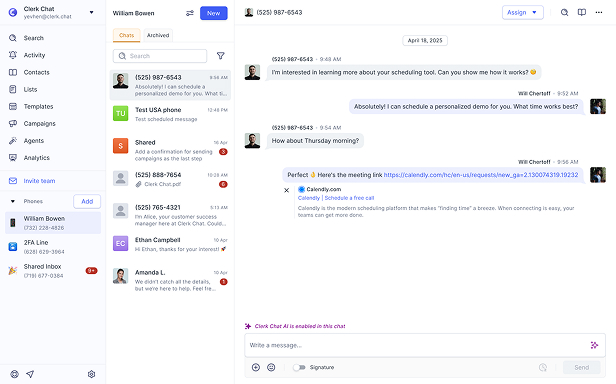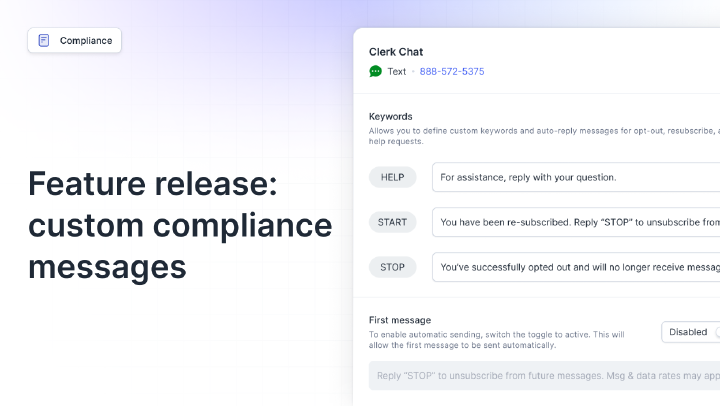A2P Messaging
[eɪ tuː piː ˈmɛsɪdʒɪŋ]A2P messaging (Application-to-Person) is automated text communication sent from business software applications to individual mobile phones. Unlike person-to-person texts, A2P messages deliver transactional alerts, marketing campaigns, and customer notifications at scale.
Why A2P Messaging Matters
A2P messaging has become essential for modern business communication, with over 8 trillion messages sent globally each year. Companies rely on A2P to reach customers instantly on their most personal devices - their phones. With 98% open rates and 90% of messages read within three minutes, A2P messaging outperforms email and other channels for time-sensitive communications.
The shift to mobile-first customer experiences makes A2P messaging critical for competitive advantage. Businesses using A2P messaging report 35% higher customer satisfaction scores and 25% faster response times compared to email-only communication. From appointment reminders that reduce no-shows to instant fraud alerts that prevent financial losses, A2P messaging directly impacts revenue and customer trust.
A2P messaging also bridges the digital divide by reaching customers without smartphones or reliable internet. This universal accessibility makes it invaluable for healthcare providers, financial institutions, and government services that must communicate with diverse populations.
How A2P Messaging Works
A2P messaging begins when a business application triggers a message based on specific events or schedules. The application sends the message request through an API to a messaging platform or aggregator. This platform validates the message content, checks recipient consent status, and formats the message according to carrier requirements.
The messaging platform then routes the message through telecommunications networks using either short codes (5-6 digit numbers), 10DLC (standard 10-digit numbers), or toll-free numbers. Each number type has different capabilities, costs, and compliance requirements. Short codes handle high volumes but cost more, while 10DLC offers local presence at lower costs.
Carriers receive the messages and apply filtering algorithms to prevent spam and ensure compliance. Messages must pass these filters to reach recipients’ phones. The entire process typically takes 1-5 seconds from trigger to delivery. Delivery receipts flow back through the same path, confirming successful delivery or providing failure reasons.
Modern A2P platforms like Clerk Chat integrate with business systems through APIs, webhooks, and pre-built connectors. This integration enables automated workflows where CRM updates, appointment systems, or e-commerce platforms trigger messages without manual intervention. Advanced platforms also support two-way conversations, allowing recipients to reply and interact with AI assistants or human agents.
Best Practices with A2P Messaging
• Obtain explicit consent before messaging - Collect and document clear opt-in consent using compliant language that explains message frequency, content types, and opt-out instructions. Store consent records with timestamps and methods for regulatory audits.
• Register for 10DLC compliance immediately - Complete carrier registration including business verification, brand registration, and campaign approval before sending any A2P messages. Non-compliance results in filtered messages and potential legal penalties.
• Personalize messages using merge variables - Include recipient names, relevant details, and contextual information to increase engagement. Generic messages get ignored while personalized ones see 3x higher response rates.
• Time messages appropriately for your audience - Send during business hours in recipients’ time zones unless urgent. Avoid early mornings, late evenings, and holidays. Test different times to find optimal engagement windows for your specific audience.
• Keep messages concise and action-oriented - Limit messages to 160 characters when possible. Lead with the most important information and include clear next steps. Every word should serve a purpose in driving the desired action.
• Monitor and respect opt-outs immediately - Process STOP requests within seconds and maintain suppression lists across all campaigns. Include opt-out instructions in recurring message series and honor all unsubscribe variants like CANCEL or UNSUBSCRIBE.
• Test thoroughly before launching campaigns - Verify message rendering across carriers, test all personalization variables, confirm links work properly, and validate opt-out processing. Small tests prevent large-scale failures.
Real world examples
- Healthcare
Appointment reminders reducing no-shows by 30% through automated texts
Read more - Retail
Order confirmations and shipping updates increasing customer satisfaction 25%
Read more
Common misconceptions
Legitimate A2P messaging requires consent and provides value to recipients, unlike spam.
A2P covers alerts, notifications, authentication, customer service, and operational updates too.
A2P messaging must follow strict regulations like 10DLC registration and TCPA guidelines.
Related terms
In this article:
Ready to use your business number for text messaging?
Thousands of businesses are already experiencing the power of conversational messaging through SMS. Join us. Free trial and paid tiers available.
Get StartedFAQ
Have questions? We've got answers.
Find what you need quickly and clearly with our most frequently asked questions.
A2P (Application-to-Person) messaging involves automated messages sent from business applications to individuals, like appointment reminders or shipping notifications. P2P (Person-to-Person) messaging is direct communication between two individuals using their personal phones. A2P requires special registration and compliance measures that P2P doesn't need.
Setting up A2P messaging involves choosing a messaging platform, registering for 10DLC compliance, obtaining customer consent, creating message templates, and integrating with your business systems. The process typically takes 2-4 weeks, including carrier registration and approval. Using a platform like Clerk Chat simplifies this by handling compliance and technical requirements.
A2P messaging costs include carrier fees ($0.01-0.03 per message), platform fees ($50-500/month), and 10DLC registration fees ($15-40 one-time). High-volume senders may get discounted rates. Total monthly costs for small businesses average $100-300, while enterprises might spend $1,000+ depending on message volume and features needed.
SMS remains the most reliable A2P channel with 98% open rates and universal device support. WhatsApp and RCS offer richer features like images and buttons but have limited reach. SMS works on every phone without apps or data plans. Many businesses use SMS as their primary channel with WhatsApp/RCS for enhanced experiences where available.
10DLC (10-Digit Long Code) registration is mandatory for A2P messaging in the US. Requirements include business verification, use case registration, message samples, and consent documentation. Processing takes 2-7 business days. Non-compliance results in message filtering or blocking. Registration costs $15-40 depending on your business type and messaging volume.
Improve delivery rates by registering for 10DLC, obtaining explicit consent, avoiding spam trigger words, sending during business hours, personalizing content, maintaining clean contact lists, and monitoring opt-out rates. Include clear sender identification and value in every message. Regular list hygiene and engagement tracking help maintain 95%+ delivery rates.




